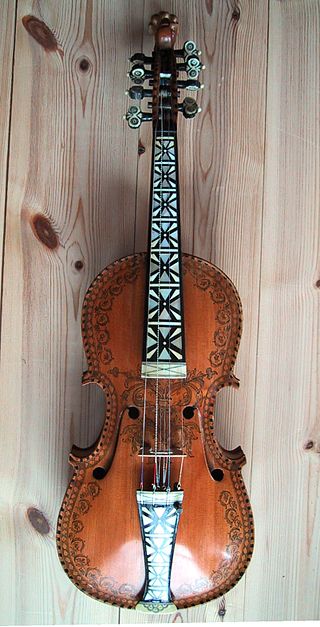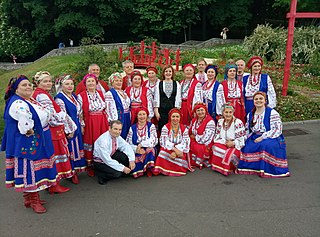Related Research Articles

A fiddle is a bowed string musical instrument, most often a violin. It is a colloquial term for the violin, used by players in all genres, including classical music. Although in many cases violins and fiddles are essentially synonymous, the style of the music played may determine specific construction differences between fiddles and classical violins. For example, fiddles may optionally be set up with a bridge with a flatter arch to reduce the range of bow-arm motion needed for techniques such as the double shuffle, a form of bariolage involving rapid alternation between pairs of adjacent strings. To produce a "brighter" tone than the deep tones of gut or synthetic core strings, fiddlers often use steel strings. The fiddle is part of many traditional (folk) styles, which are typically aural traditions—taught "by ear" rather than via written music.

Bluegrass music is a genre of American roots music that developed in the 1940s in the Appalachian region of the United States. The genre derives its name from the band Bill Monroe and the Blue Grass Boys. Like mainstream country music, it largely developed out of old-time string music, though in contrast, bluegrass is traditionally played exclusively on acoustic instruments and also has roots in traditional English, Scottish, and Irish ballads and dance tunes as well as in blues and jazz. Bluegrass was further developed by musicians who played with Monroe, including 5-string banjo player Earl Scruggs and guitarist Lester Flatt. Monroe characterized the genre as, "Scottish bagpipes and ole-time fiddlin'. It's a part of Methodist, Holiness and Baptist traditions. It's blues and jazz, and it has a high lonesome sound."

Much has been learned about early music in Norway from physical artifacts found during archaeological digs. These include instruments such as the lur. Viking and medieval sagas also describe musical activity, as do the accounts of priests and pilgrims from all over Europe coming to visit St Olav's grave in Trondheim.
The polska is a family of music and dance forms shared by the Nordic countries: called polsk in Denmark, polka or polska in Estonia, polska in Sweden and Finland, and by several different names in Norway. Norwegian variants include pols, rundom, springleik, and springar. The polska is almost always seen as a partner dance in, although variants in 2
4 time, as well as in compound meters also exist.

The langeleik, also called langleik, is a Norwegian stringed folklore musical instrument, a droned zither.

A Hardanger fiddle is a traditional stringed instrument considered to be the national instrument of Norway. In modern designs, this type of fiddle is very similar to the violin, though with eight or nine strings and thinner wood. The F-holes of the Hardanger fiddle are distinctive, oftentimes with a more "sunken" appearance, and generally straighter edges. Four of the strings are strung and played like a violin, while the rest, named understrings or sympathetic strings, resonate under the influence of the other four. These extra strings are tuned and secured with extra pegs at the top of the scroll, effectively doubling the length of a Hardingfele scroll when compared to a violin. The sympathetic strings, once fastened to their pegs, are funneled through a "hollow" constructed fingerboard, which is built differently than a violin's, being slightly higher and thicker to allow for these extra strings. The resonant strings lie on the center of the special bridge, attached to extra hooks on the tailpiece. Carved out within the center of the bridge is a smaller secondary "bridge", or opening, designed specifically for these resonant strings to pass through. This is where the resonance is picked up and reverberated; as notes are played, the vibrations are sent through the bridge, where the sympathetics echo those notes.

Old-time music is a genre of North American folk music. It developed along with various North American folk dances, such as square dancing, clogging, and buck dancing. It is played on acoustic instruments, generally centering on a combination of fiddle and plucked string instruments, most often the banjo, guitar, and mandolin. The genre is considered a precursor to modern country music.

Bunad is a Norwegian umbrella term. In a broader sense, the term encompasses household, householding equipment, and livestock as well as both traditional rural clothes and modern 20th-century folk costumes. In its narrowest sense, the word bunad refers only to clothes designed in the early 20th century that are loosely based on traditional costumes.

Rose-painting, rosemaling, rosemåling or rosmålning is a Scandinavian decorative folk painting that flourished from the 1700s to the mid-1800s, particularly in Norway. In Sweden, rose-painting began to be called dalmålning, c. 1901, for the region where it had been most popular and kurbitsmålning (kurbits), in the 1920s, for a characteristic trait, but in Norway the old name still predominates beside terms for local variants. Rose-painting was used to decorate church walls and ceilings. It then spread to wooden items commonly used in daily life, such as ale bowls, stools, chairs, cupboards, boxes, and trunks. Using stylized ornamentation made up of fantasy flowers, scrollwork, fine line work, flowing patterns and sometimes geometric elements give rose-painting its unique feel. Some paintings may include landscapes and architectural elements. Rose-painting also utilizes other decorative painting techniques such as glazing, spattering, marbleizing, manipulating the paint with the fingers or other objects. Regional styles of rose-painting developed, and some varied only slightly from others, while others may be noticeably distinct.
Here Northumbria is defined as Northumberland, the northernmost county of England, and County Durham. According to 'World Music: The Rough Guide', "nowhere is the English living tradition more in evidence than the border lands of Northumbria, the one part of England to rival the counties of the west of Ireland for a rich unbroken tradition. The region is particularly noted for its tradition of border ballads, the Northumbrian smallpipes and also a strong fiddle tradition in the region that was already well established in the 1690s. Northumbrian music is characterised by considerable influence from other regions, particularly southern Scotland and other parts of the north of England, as well as Irish immigrants.
Russian folk music specifically deals with the folk music traditions of the ethnic Russian people.
Balkan music is a type of music found in the Balkan region of southeastern Europe. The music is characterised by complex rhythm. Famous bands in Balkan music include Taraf de Haïdouks, Fanfare Ciocărlia, and No Smoking Orchestra.

Hallingdal is a valley as well as a traditional district located in the traditional and electoral district Buskerud in Viken county in Norway. It consists of six municipalities: Flå, Nes, Gol, Hemsedal, Ål and Hol.

Traditional Nordic dance music is a type of traditional music or folk music that once was common in the mainland part of the Nordic countries — Scandinavia plus Finland. The person who plays this kind of music might be called speleman (Swedish/Norwegian), spelman (Swedish), spel(l)emann (Norwegian), pelimanni (Finnish) or spillemand (Danish). Finnish traditional dance music is often called pelimanni music in English, while there does not seem to exist a similar, widespread term for the corresponding music from the other countries. It is often more meaningful to distinguish between the traditional dance music from different regions than between music from the countries as such. Some concepts in the field can be defined as Norwegian or Finnish, but most are either common to all four countries or local. Besides the dance music tradition, all countries also have other traditions of folk music that are not shared to a similar extent.
Gammaldans (Swedish) or Gammeldans is a small set of Nordic dances that became broadly popular in the late 19th century. These were also the dances of the Nordic immigrant communities in the United States.

Ukrainian folk music includes a number of varieties of traditional, folkloric, folk-inspired popular music, and folk-inspired European classical music traditions.
Twin Cities Hardingfelelag is an amateur folk music group in the Twin Cities, United States, specializing in Norwegian folk music played on the Hardingfele.

Irish traditional music is a genre of folk music that developed in Ireland.
Norwegian National Association for Traditional Music and Dance(Norsk Folkemusikk- og Danselag) is a nationwide organization that aims to support the folk music and rural dance tradition in Norway.
European dances refers to various dances originating in Europe. Since Medieval ages, many European dances tend to be refined, as some are based on the court dances of aristocrats.